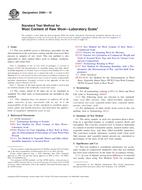Potřebujeme váš souhlas k využití jednotlivých dat, aby se vám mimo jiné mohly ukazovat informace týkající se vašich zájmů. Souhlas udělíte kliknutím na tlačítko „OK“.
ASTM D584-10
Standard Test Method for Wool Content of Raw Wool-Laboratory Scale
Automaticky přeložený název:
Standardní zkušební metoda pro vlnu obsah surové vlny, laboratorním měřítku
NORMA vydána dne 1.6.2010
Informace o normě:
Označení normy: ASTM D584-10
Poznámka: NEPLATNÁ
Datum vydání normy: 1.6.2010
Kód zboží: NS-32747
Počet stran: 6
Přibližná hmotnost: 18 g (0.04 liber)
Země: Americká technická norma
Kategorie: Technické normy ASTM
Kategorie - podobné normy:
Anotace textu normy ASTM D584-10 :
Keywords:
clean wool content, raw wool, yield, Clean fiber content, Extractable matter content--textile fabrics/fibers, Wool and wool top, Wool and wool top--raw, Wool content--raw wool, ICS Number Code 59.060.10 (Natural fibres)
Doplňující informace
| Significance and Use | ||||||||||||||||||||
|
This test method is considered satisfactory for acceptance testing of commercial shipments since this test method has been used extensively in the trade for acceptance testing. In case of dispute arising from differences in reported test results when using Test Method D584 for acceptance testing of commercial shipments, the purchaser and the supplier should conduct comparative testing to determine if there is a statistical bias between their laboratories. Competent statistical assistance is recommended for the investigation of bias. As a minimum, the two parties should take a group of test specimens that are as homogenous as possible and that are from a lot of the type material in question. The test specimens should then be assigned in equal numbers to each laboratory for testing. The average results from the two laboratories should be compared using Student's t-test for unpaired data and an acceptable probability level chosen by the two parties before testing is begun. If a bias is found, either its cause must be found and corrected or the purchaser and the supplier must agree to interpret future test results in the light of known bias. The wool-base content of wool in any condition or form is a basic quantity. From it may be calculated commercial masses or yields in any of the various recognized defined systems used in international commerce (Note 1). The procedures for determining the wool base content of greasy wool provided in this test method and in IWTO Method 19-85(E) are in essential agreement. Note 3—This is not true for scoured wool, as IWTO Method 19-85(E) does not require rescouring of scoured wool containing less than 5% residual grease. Not all of the wool base present in a lot of raw wool can be recovered in useful form by commercial cleaning operations. The amount of wool loss varies, depending on factors such as the character of the wool, the nature and percentage of the impurities present, the cleaning process and equipment used, and so forth. No ASTM standard specifies or recommends any specific procedure or practice for estimating anticipated loss of wool during commercial cleaning (or other) operations. The following statutory practice is described solely for information: For the purpose of duty assessment on importations of raw wool into the United States, the Tariff Schedules of the United States provides a statutory formula for calculating the allowance to be made for wool “that would ordinarily be lost during commercial cleaning operations.” The formula is based on the clean wool fiber present (called “absolute clean content” in the Tariff Schedules) and on the vegetable matter present. The allowance, in terms of clean wool fiber present, is equal to 0.5 % of the clean wool fiber present plus 60 % of the vegetable matter present, the total allowance not to exceed 15 % of the clean wool fiber present. The dutiable quantity (called “clean yield” in the Tariff Schedules) is the difference between the clean wool fiber present and the allowance so calculated. |
||||||||||||||||||||
| 1. Scope | ||||||||||||||||||||
|
1.1 This test method covers a laboratory procedure for the determination of the wool base content and the clean wool fiber present in samples of raw wool. This test method is also applicable to other animal fibers such as mohair, cashmere, alpaca, and camel hair. Note 1—Sampling of lots of raw wool in packages is covered in Practice D1060; the determination of vegetable matter and other alkali-insoluble impurities in scoured wool is covered in Test Method D1113; the determination of wool content on a commercial scale is covered in Test Method D1334. For factors for the conversion of woolbase content to its equivalent in terms of scoured wool, top, or noil of various commercially specified compositions (formerly covered in the appendix of this test method), refer to Practice D2720. Note 2—Because of the trade practice the term weight is used in this test method instead of the technically correct term mass. 1.2 The values stated in SI units are to be regarded as standard. No other units of measurement are included in this standard. 1.3 This standard does not purport to address all of the safety concerns, if any, associated with its use. It is the responsibility of the user of this standard to establish appropriate safety and health practices and determine the applicability of regulatory limitations prior to use. |
||||||||||||||||||||
| 2. Referenced Documents | ||||||||||||||||||||
|
Doporučujeme:
EviZak - všechny zákony včetně jejich evidence na jednom místě
Poskytování aktuálních informací o legislativních předpisech vyhlášených ve Sbírce zákonů od roku 1945.
Aktualizace 2x v měsíci !
Chcete vědět více informací? Podívejte se na tuto stránku.




 Cookies
Cookies
